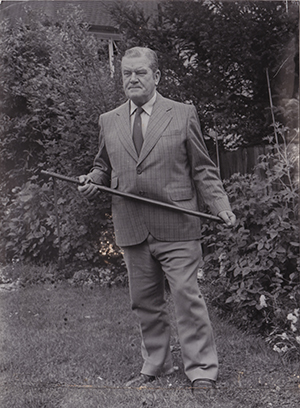A doctor’s sword
Published in Issue 6 (November/December 2016), Reviews, Volume 24Gambit Pictures, RTÉ1, 25 August 2016
Bob Jackson, A doctor’s sword: how an Irish doctor survived war, captivity and the atomic bomb (Collins Press, €22.99 hb, 304pp, ISBN 9781848892866)
By John Gibney

Above (Top): Dr Aidan MacCarthy in his RAF uniform.
————————————————–
Above: POW camp commandant Isao Kusuno with the sword he later gifted to Aidan McCarthy.
The wider story is that of Irish service in the British armed services during the Second World War; the individual story is that of Aidan MacCarthy, whose family had opened the pub in Castletownbere in the mid-nineteenth century. During the First World War, Castletownbere was used as a base by both the Royal and US navies, which ensured a constant stream of business into the town, as the ships needed to be supplied and the crews on leave kept reasonably entertained. In economic terms, the town did well out of the war, and the MacCarthy family did well enough for Aidan MacCarthy to be sent to Clongowes Wood College, thence to study medicine; he graduated in 1930. Yet in the Ireland of the 1930s the young Dr MacCarthy was unable to find a job; the economic climate was bad enough, but, given his background, he could not get a foothold in a medical profession that was essentially a closed shop. He emigrated to England, and after a boozy night with some fellow doctors from Cork he joined the RAF.
MacCarthy served in France during the ‘Phoney War’ of 1939–40 and was present at the British evacuation from Dunkirk. After a stint in England (where he narrowly avoided being killed by a bomber that crash-landed on a stockpile of bombs), he was posted to Singapore on a convoy filled with fighter aircraft, but they were too late; it had already fallen. MacCarthy was eventually captured by the Japanese and was imprisoned for three and a half years in appalling conditions in a variety of locations. The Japanese military tradition, contemptuous of surrender, extended that contempt to opponents who had surrendered; their treatment of Allied POWs across the Pacific theatre was genuinely horrific. McCarthy himself was beaten badly on numerous occasions; after one beating he was forced to undergo an operation to remove damaged cartilage from his arm without anaesthetic.
Allied prisoners were essentially slave labour to the Japanese; their usefulness in this regard kept them alive, though their captors deemed them expendable. They were often moved around as required, and as MacCarthy was being ferried to Japan in June 1944 the freighter he was on was torpedoed by a US submarine (MacCarthy later met the US captain). He and his fellow survivors were in the water for twelve hours, where he sought to minister to the wounded and witnessed Australian POWs beat some of their former captors to death before they were rescued by a Japanese destroyer. The crew were initially unclear who they had captured; when they realised, they began to beat the prisoners unconscious and throw them overboard. MacCarthy and a number of others made a break for it, jumping overboard only to be picked up by Japanese whalers who landed the handful of survivors at Nagasaki. Ordered to dump the prisoners at sea, the whalers refused to do so, and so MacCarthy ended up working in shipyards and at the Mitsubishi factory. He was in Nagasaki when it was destroyed by a US nuclear attack in August 1945—he and others had seen the planes but had been sheltering in an underground bunker a mile from the epicentre of the blast and survived. And this returns us to the sword, which he received from Isoa Kusano, the commandant of his POW camp, after the Japanese unconditional surrender.

Above: Aidan MacCarthy in later years with the ‘samurai sword’.
 MacCarthy told his story in his own words before, so we get to hear his voice, from an RTÉ documentary that, coincidentally, was broadcast on the day of his funeral. Bob Jackson’s excellent documentary deploys copious footage from the war, with striking and sparse animations used to fill the visual gaps in MacCarthy’s tale. This is an extremely well-made documentary. Jackson has expanded on the story in his accompanying book, which provides a rich contextualisation that could not be incorporated into the film. He writes extremely well, and has written a compulsively readable book. The book and the documentary are not mutually exclusive; they complement each other, and in their differing ways tell what is surely one of the most compelling stories ever likely to be told of an Irish involvement in the Second World War.
MacCarthy told his story in his own words before, so we get to hear his voice, from an RTÉ documentary that, coincidentally, was broadcast on the day of his funeral. Bob Jackson’s excellent documentary deploys copious footage from the war, with striking and sparse animations used to fill the visual gaps in MacCarthy’s tale. This is an extremely well-made documentary. Jackson has expanded on the story in his accompanying book, which provides a rich contextualisation that could not be incorporated into the film. He writes extremely well, and has written a compulsively readable book. The book and the documentary are not mutually exclusive; they complement each other, and in their differing ways tell what is surely one of the most compelling stories ever likely to be told of an Irish involvement in the Second World War.
John Gibney is Education and Outreach Officer at Glasnevin Cemetery Museum.
















